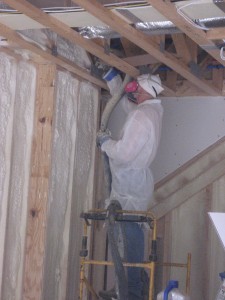 So, now I am going to count up our points under the Energy & Atmosphere prescriptive path, and see if we get more points this way than going down the performance path with the HERS rating. I am also going to learn more about the components of an energy efficient house.
So, now I am going to count up our points under the Energy & Atmosphere prescriptive path, and see if we get more points this way than going down the performance path with the HERS rating. I am also going to learn more about the components of an energy efficient house.
For insulation, the intent is to design and install insulation to minimize heat transfer and thermal bridging. Insulation is typically one of the best bang-for-the-buck investments, particularly in our climate. Insulation is measured in terms of R-values, which gives a number to its thermal effectiveness. The higher the R-value, the higher the resistance to heat flow through the insulation. The prerequisite is for basic insulation, and 2 points can be earned for enhanced insulation:
a. Install insulation that meets or exceed the R-value requirements listed in Chapter 4 of the 2004 INternational Energy Conservation Code. (2 points if we exceed this by at least 5%.)
b. Install insulation to meet the Grade II (or Grade I for “enhanced insulation” — 2 points) specifications set by the National Home Energy Rating Standards. Installation must be verified by an energy rater conducting a pre-drywall thermal bypass inspection.
Note: for any portion of the home constructed with SIPs (structural insulated panels) or ICFs (insulated concrete forms), the rater must conduct a modified visual inspection.
Our choice of insulation was one of the toughest decisions for me. Getting up the learning curve on all the different types of insulation and making an educated guess was a long process. We also had a deadline — once the house was framed and wired, we needed to make the decision or further delay the building process. I devote a whole chapter to this decision in my book (which I hope to be available soon), so I won’t go into the trials and tribulations of insulation here on my blog. After all, I’m just trying to count up the LEED points, right?!
But what in the world does all this mean? Chapter 4 of the 2004 International Energy Conservation Code? I have a hard time finding this. The Reference Manual suggests using RESCHECK, a free web model developed by the U.S. Department of Energy that helps determine whether a home’s insulation levels meet the IECC requirements. I go to check on this model, and it requires many inputs: square footage of walls, ceilings, windows, doors, plus the U-values of the windows and doors and the R-values of the insulation. Some of these things I know, some I have to estimate. The reality is that there is not just one “R-Value” for insulation. You have to take into account what the structure is made of (wood or metal, e.g.) and how many inches of insulation are installed.
What I do know is that we used closed-cell spray foam on all exterior walls and ceilings (the actual type was BASF Comfort Foam 178 Series). The issue I had with this type of insulation is the ingredients. Workers are exposed to cancer-causing chemicals that are mostly rated as possible and known carcinogens. Once it is installed, though, it becomes inert. Because we live in Minneapolis, we wanted the top-rated insulation for energy savings as well as for comfort. Closed-cell spray foam not only has the highest R-value per inch (about 6.0), it also has the added benefit of finding its way around outlet holes and and can cozy right up to any openings–a vast improvement over fiberglass insulation. Additionally, the American Lung Association recommends this type of insulation because it is the best way to prevent mold.
Getting to the point: when I enter all my best guesses into the online model, it says I passed by 29%. I am pretty sure we would get two points here.
EA Prescriptive Path Points so far: 2
